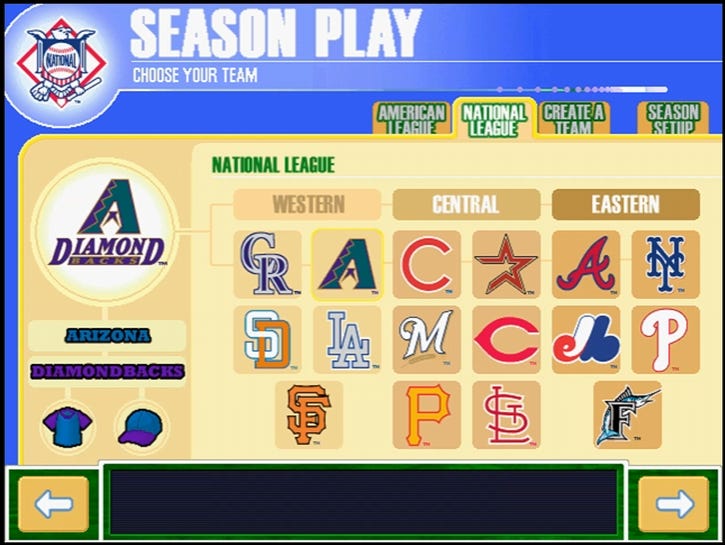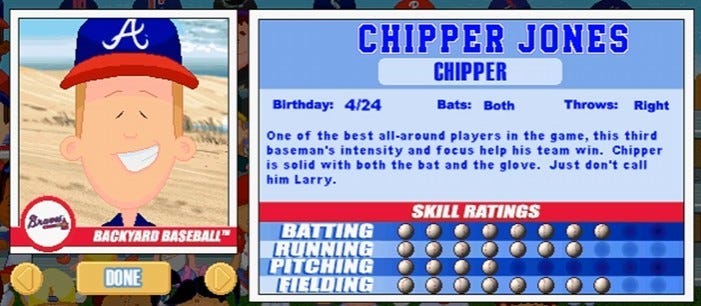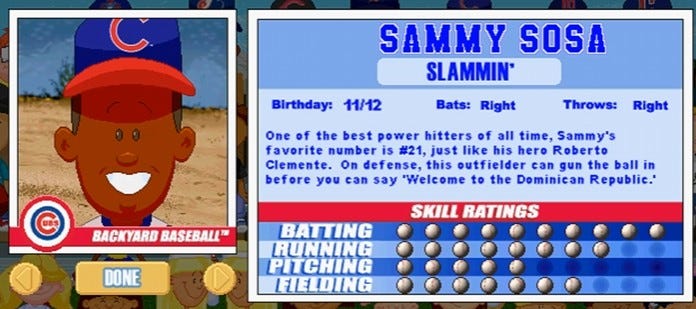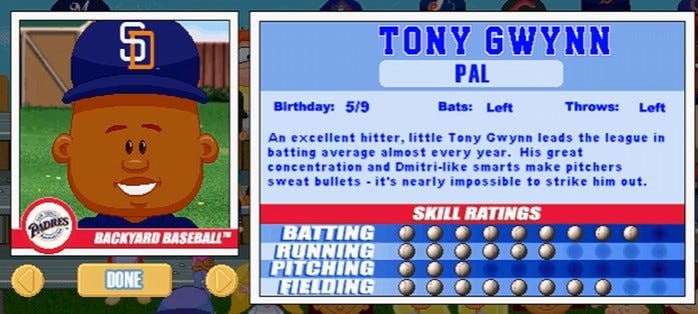Who Belongs in the Next Backyard Baseball? (Part II: National League)
Fifteen kid‑size National League stars—Acuña’s fireworks, Ohtani’s cheat‑code magic, Skenes’ flamethrower, and twelve more picks to complete the two‑part Backyard Baseball lineup that began with Tuesd
Good morning, sports fans!
We're now two days removed from the 2025 MLB All-Star Game in Atlanta, and there's a lot to unpack, marvel at, and note. We won't be able to cover everything today. Still, there are a few things I want to highlight before we get into the meat of today's fun—the second part, the National League edition, of our 'Who Belongs in the Next Backyard Baseball?' series, highlighting my half-smart/half-wish list of modern picks for future Backyard Baseball games.
First off, in case you missed it, you need to see the 6th-inning tribute to Hank Aaron from Tuesday night's All-Star Game in Atlanta. Held on July 15 (aka 7/15), it was the perfect time and way to honor the greatest Brave and arguably the greatest baseball player of all time for initially breaking Babe Ruth's then all-time home run record of 715. The symmetry is quite cool, and of course, for some, he's still seen as the true home run king when you account for Barry Bonds' alleged steroid use—especially compared to Aaron's legacy as a civil rights advocate, his and his wife Billye's commitment to philanthropy and platforming support organizations like the NAACP, and the co-founding the Hank Aaron Chasing the Dream Foundation.
With projection-mapped immersive visuals projected across the field, custom pyrotechnics, and the original broadcast call over the loudspeakers, fans were treated to a reimagining of Aaron's historic 715th home run. And so the tale of Hammerin' Hank endures, chronicled not only in the records but in the reverent lights and shadows cast upon the hallowed field of play—a spectacle for all ages to remember.
Aside from that, it was awesome to see former Atlanta Braves star and legendary New York Yankees manager Joe Torre make a mound visit in full Yankee uniform. Torre is more well-known among younger fans as the manager of the late 90's Yankees dynasty, and rightfully so, but he also earned five straight All-Star game nods from 1963-1967 after joining the franchise in Milwaukee in 1960 and playing with the team after their move to New York until 1976.
The All-Star Game MVP honors went to another former catcher like Torre in Kyle Schwarber. The primary DH for the Philadelphia Phillies went deep three times in the first-of-its-kind swing-off format—a sudden-death home run contest where each team sends up three batters for a round of swings, with the team hitting the most homers declared the winner. It's MLB's answer to penalty kicks, replacing traditional extra innings to settle tied All-Star Games. Schwarber had replaced Ohtani earlier in the game, going 0-2 with a walk in three plate appearances, but it didn't matter in the end. The Schwarbombs he launched in the swing-off did, making him the second Phil to ever earn the award after Johnny Callison in 1964.
And speaking of derby drama from Monday night: Cal "Big Dumper" Raleigh became the first catcher to win the Home Run Derby. He edged Brent Rooker in Round 1 when Statcast measured Raleigh's longest shot at 471 feet-seven-eighths of an inch farther than Rooker's best. Raleigh then dethroned Junior Caminero in the finals, 18‑15. Maybe Caminero should've been my pick for the Rays, but it's too late now! And Lowe still ain't too shabby—more on the Derby and swing-offs in general next week. The NFL likes to call itself a game of inches; this week MLB claimed a few for itself.
Speaking of players who feel larger than life—with All‑Star week still buzzing and one day left on the technically just past the half-season break, it's time to finish our Backyard Baseball half-smart/half-wishlist. On Tuesday, we built the American League squad in Part I; today, the National League gets its turn. Acuña's five‑tool fireworks, Ohtani's two‑way cheat code, Skenes' flamethrower cameo, and a few pixel‑perfect prospects you'll want batting behind Pablo.
Same house rules: one player per team, no CBA clauses—just maximum sandlot drama. Grab a juice box, hit the power-up, and meet the NL crew ready to join Pablo, Keisha, and the rest in the Backyard.
National League East
Atlanta Braves — Ronald Acuña Jr. (OF)
There’s probably no player more Backyard-coded than Ronald Acuña Jr. He plays with the volume turned up: giant swing, explosive speed, a cannon arm, and the kind of charisma that would make him the first kid picked every time. He hits moonshots, steals bases in bunches, and plays the outfield like it’s a track meet. If Backyard Baseball had an “electricity meter,” Acuña would start every game at full charge.
Even after his season-ending ACL tear in 2024, his impact on the Braves — and the game — is undeniable. He’s one of the few players who can tilt the field in every phase. He makes baseball feel like a video game, and in this format, that’s the whole point.
Honorable mentions: Spencer Strider was a real contender here — the goggles, the mustache, the strikeout totals, and that full-throttle delivery all scream Backyard Baseball starter. Matt Olson, meanwhile, has the kind of lefty power that would have him hitting homers into the neighbor’s grill. But Acuña brings the chaos, charisma, and five-tool fun that defines the entire game. He’s the pick.
Miami Marlins — Sandy Alcántara (RHP)
Sandy Alcántara hasn’t looked like a Cy Young winner in 2025 — his ERA is north of 7.00, and the sharpness just hasn’t been there. But he’s still the most recognizable name on the roster and the kind of high-variance, high-upside starter who feels right at home in a Backyard Baseball lineup. His delivery is lanky and elastic, his mound presence is theatrical, and when he’s locked in, he still looks like someone who could strike out the side on nine pitches with one eye closed.
Also — this is the Marlins. Their entire organizational identity revolves around trading away their best player every time one breaks out. So even if Alcántara is in a different uniform by release day, he still makes the most sense as the pick today.
Honorable mentions: Edward Cabrera has been more stable and might be the best pitcher on the team right now. Eury Pérez still feels like the future ace if he gets healthy. Otto López is making noise all over the diamond and has a real Backyard skillset: contact, wheels, and versatility. But for now, Sandy’s still the name on the box.
New York Mets — Francisco Lindor (SS)
Francisco Lindor is built for Backyard Baseball. He plays with flair, turns double plays like choreography, and brings style to everything he does — from his glove work to his at-bats. Even in a Mets era full of reset buttons and rotating stars, Lindor remains the constant: a switch-hitting shortstop with Gold Glove defense and one of the most complete games in baseball.
He’s smooth, expressive, and dependable — the kind of player who fits perfectly at short (or anywhere you'd put him, probably), in real life or pixel form.
Honorable mentions: Juan Soto might be the best pure hitter in the league and brings plenty of Backyard swagger with his signature shuffle. Pete Alonso offers big-swing chaos and cartoon home run power. However, Lindor is the cleanest and most complete choice.
Philadelphia Phillies — Bryce Harper (OF)
Bryce Harper was probably born to be in Backyard Baseball. He’s got the bandana, the bat speed, the eye black, the stare-downs — and the swing that looks like it was designed in an arcade machine. He’s emotional in the best way, theatrical without feeling phony, and constantly comes through in big moments. If Pablo Sanchez needed a cleanup hitter with cartoon intensity and MVP credentials, this is the guy.
He's also one of the few players whose aura would change the whole lineup — the kind of presence that makes your team feel like it’s playing in a championship, even if it’s just game one on Tin Can Alley.
Honorable mentions: Zack Wheeler was the original pick and would still be the ace if this roster needed more pitching — he’s been one of the best starters in baseball over the past four seasons and has a real shot at Cooperstown. But the Phillies might be the most stacked Backyard-ready team in the league. Trea Turner brings elite shortstop athleticism, Kyle Schwarber is a three-homer game waiting to happen that you can slot in behind the dish, and Nick Castellanos has built a career on swinging at chaos — and hitting a home run in the middle of it. But Harper’s the one you build around.
Washington Nationals — James Wood (OF)
James Wood resembles the Backyard Baseball create-a-player screen, as if someone had maxed out all the sliders. At 6-foot-7, he covers ground in the outfield like the dictionary definition of an athlete, and he hits baseballs as hard as anyone in the game. He took that energy to the 2025 Home Run Derby, launching moonshots—one measured at 486 feet—before bowing out after a strong run in the first round. In Backyard terms, he’s the kid who clears the fence, outruns the throw, and makes the game feel a little more unreal every time he steps to the plate.
Honorable mentions: MacKenzie Gore has ace upside for the rotation, and Dylan Crews, last summer’s No. 2 overall pick, projects as a future franchise cornerstone. But Wood’s size, swagger, and slugging put him firmly in playground legend territory.
Chicago Cubs — Pete Crow-Armstrong (OF)
Pete Crow-Armstrong plays center field like he’s trying to take away every fly ball in the entire ZIP code. His jumps are elite, his routes are perfect, and his glove never takes a pitch off. He’s still refining the bat, but in Backyard Baseball terms, he’s the kid you lock into center and forget about — because nothing’s getting past him anyway.
He brings a particular backyard profile: defense, speed, and chaos. The kind of player who stretches a single into a triple and then robs a homer the following inning like it’s nothing.
Honorable mentions: Shota Imanaga has pitched like an ace since the moment he arrived — funky delivery, pinpoint control, and the kind of calm you don’t teach. Seiya Suzuki is one of the most complete outfielders in the league and fits the pixel-perfect swing mold. The two would be more than just diversity picks to be sure, but PCA is the guy here—He’s a blur who makes the field feel smaller with his glove and his bat.
Cincinnati Reds — Elly De La Cruz (SS)
Elly De La Cruz might be the most video game–coded player in baseball. He’s 6-foot-5, plays shortstop like a track star with a cannon, and fills the box score like someone mashing buttons. He’s already one of the MLB The Show 25 cover athletes, launched a 486-foot homer at the 2025 Derby, and became one of the only players in MLB history to hit both an inside-the-park and over-the-fence home run in the same game. (Yes, Byron Buxton could pull it off, too — but Elly’s already done it.)
What makes Elly even more Backyard-worthy is how unpredictable he is — you never know if you’re getting three strikeouts, three stolen bases, or both. But no matter what, you’re watching. And in a game built on flair, movement, and chaos, that’s the entire point.
Honorable mentions: Hunter Greene throws 102 with upper-90s,s cool and looks like the prototype for a Backyard fireballer. In a pitching-focused version of this list, he’s a real contender. But Elly is the engine, the show, and the cheat code — the Reds’ Playground Pablo.
Milwaukee Brewers — Christian Yelich (OF)
Christian Yelich might not be putting up MVP numbers anymore, but he’s still the Brewers’ identity. He’s smooth, lefty, and quietly clutch — the kind of player who’d rope a double off the backyard garage door and jog into second without saying a word. He’s also been in Milwaukee long enough to feel like a franchise avatar, someone who’s endured the team’s complete evolution from underdog upstart to perennial playoff presence.
He’s not the loudest name on this list, but he fits the Backyard format because he doesn’t need to force anything. He plays. He runs well, throws well, hits to all fields, and still finds a way to stand out — even when you’re not looking for him.
Honorable mentions: Freddy Peralta has taken the reins as the club’s ace, with elite strikeout stuff and Backyard-ready mound presence. Jackson Chourio is one of the most exciting young players in the league and may very well take this spot in a year or two. But for now, Yelich is still the guy — steady, stylish, and low-key elite in a format that rewards all of it.
St. Louis Cardinals — Nolan Arenado (3B)
Nolan Arenado has been the best defensive third baseman of his generation, and he still plays the position with the kind of flair that turns ground balls into theatre. Even if the offense has cooled, he’s still a vacuum at the hot corner — charging bunts, barehanding rollers, making throws across his body like it’s clockwork. In a Backyard Baseball setting, he’s the corner infielder who dives on concrete, flips his cap around, and makes the out anyway.
He’s also the kind of player who elevates the infield around him — locked-in, intense, and precise without being flashy for the sake of it. He feels like a natural fit alongside Backyard staples like Dmitri Petrovich or Angela Delvecchio — the steadiest hand on a team full of chaos.
Honorable mentions: Masyn Winn brings speed, range, and emerging star energy at shortstop. Brendan Donovan is a true Backyard utility player — he plays everywhere and does a little bit of everything. Sonny Gray has been the team’s best pitcher in 2025 and would’ve cut if this list leaned more rotation-heavy. But Arenado still feels like the most complete fit — a defensive anchor with Backyard instincts baked in.
Pittsburgh Pirates — Paul Skenes (RHP)
Paul Skenes is throwing 100, commanding a slider that looks unfair, and carrying himself like he’s been in the league five years instead of five minutes. Before becoming LSU’s ace and going No. 1 overall, he was a two-way player at Air Force — catching and pitching, which only adds to the appeal. And now, he’s one of the three MLB The Show 25 cover athletes, alongside Gunnar Henderson and Elly De La Cruz. He’s perfect for the Backyard.
Every start feels like a marquee event. You know the neighborhood kids would be lining up in the stands to watch him throw. And on a team still figuring itself out, he already feels like the main character.
Honorable mentions: Oneil Cruz, now roaming center field at 6-foot-7, still feels like someone programmed into a video game by accident. Andrew McCutchen would’ve been a shoo-in for years — 2013 NL MVP, face of the franchise, and pure Backyard energy. But this is Skenes.
National League West
Colorado Rockies — Hunter Goodman (C/1B/OF)
Hunter Goodman might be the most naturally gifted hitter in the Rockies’ system. That’s saying something. He’s a right-handed catcher-masher with a growing positional versatility—and one of the few bright spots in a dreadful season. he'sfoot-3 he’s got the size to anchor a lineup and the athleticism to play multiple positions — precisely the kind of versatility Backyard Baseball rosters thrive on.
He’s still establishing himself at the big-league level, but the tools are undeniable. In a format where every player needs to do a little bit of everything, Goodman feels like the perfect wild card — the rookie who shows up and immediately makes your team better.
Honorable mentions: Ryan McMahon has been a steady presence at third base with sneaky power numbers, though like others on his list, he’s a prime trade target this year’s deadline. Ezequiel Tovar brings real shortstop athleticism and emerging offensive upside. But Goodman has the ceiling, the position flexibility, and the kind of raw talent that would make him a Backyard sleeper pick who turns into a lineup anchor.
San Francisco Giants — Logan Webb (RHP)
doesn’t throw the hardest or yell the loudest, but he keeps showing up and shoving. He’s led the National League in innings multiple times, has a sinker that bores itsike it’s remote-controlled, and pitches like who’s already played the game in his head before it starts. If Backyard Baseball had a workhorse archetype, Webb doesn’t need flash to dominate — he pounds the zone, gets grounders, and walks off like it’s no big deal. The Backyard equivalent of the kid who brings his glove, shows up on time, and casually throws a complete game.
Honorable mentions: Willy Adames brings power and veteran energy to the infield, and Rafael Devers, newly arrived from Boston, is still one of the most dangerous bats in the league. But Webb is the face of the Giants now — steady, reliable, and built to go the distance.
San Diego Padres — Fernando Tatis Jr. (OF)
Fernando Tatis Jr. is the embodiment of Backyard Baseball. He swings with the kind of abandon that makes every at-bat feel like it could end in fireworks, roaming the outfield as if he's choreographing a highlight reel, and brings a swagger that would make him the first kid picked in any sandlot draft. His bat flips are legendary, his speed is electric, and his cannon arm from the outfield could probably reanimate a neighbor's's y. He's the kind of guy who'd hit a grand slam, steal home in the same inning, and then gun down a runner at the plate — all while grinning, he's having the time of his life.
He's settled into the outfield full-time, his athletic versatility means he could slot in anywhere on a Backyard diamond. And with that rocket arm, he’s probably throwing an inning or two in relief, just because he can. Even after returning from injury, Tatis remains the most naturally gifted and charismatically explosive player in the game. In a format built on flair, fun, and making the impossible his routine, he's not just a sect fit — he's the template.
Honorable mentions: Manny Machado brings veteran leadership and Gold Glove defense at third base, the kind of presence who'd anchor any Backyard infield. His swing is pure, and his baseball IQ is off the charts — precisely thwho'dd of player who'd make everyone around him better. But this is Tatis' show, and Tatis' Backyard to rule.
Los Angeles Dodgers — Shohei Ohtani(DH/P)
There's never been anyone like Shohei Ohtani, and there probably never will be again. He hits baseballs into orbit, throws 100+ mph fastballs that look like they're shot from a cannon, and does it all with the kind of calm precision that makes the impossible look effortless. In a Backyard Baseball context, he's the ultimate cheat code — the kid who can close out the game on the mound, then lead off the next inning and launch a home run. He's not just a two-way player; he's a video game character come to life.
His combination of power, speed, and pitching dominance breaks every conventional rule of roster construction. In the Backyard, everyone's supposed to do a little bit of everything, and Ohtani does everything at an elite level. He's not just the best player in baseball — he's the most perfectly designed Backyard Baseball player ever created.
Honorable mentions: Freddie Freeman brings clutch hitting and veteran savvy, the kind of pure hitter who'd find a way to rope doubles no matter what the situation. Mookie Betts is a five-tool superstar with Gold Glove defense and championship pedigree — he's played everywhere from second base to the outfield and excels at each (short)stop, exactly the complete player who'd thrive in any Backyard format. Clayton Kershaw would've been a shoo-in for years — a future Hall of Famer, franchise icon, and the kind of lefty ace who defined you've. But when you don't think about it, you don't think about it. He's the unicorn, the legend, and the pick.
The Spirit of the Game
When I wrote about the Backyard Sports revival earlier this year, it wasn’t just about bringing back old games — it was about recapturing a feeling. The energy, the personality, the way it made every player feel larger than life without needing to be taken too seriously. That’s what this list is chasing; not just who’s best right now, but who feels like they belong in the Backyard, stretching singles into inside-the-park home runs off a wild undergrounders, making sure everyone’s included, stepping up to the plate with Pablo Santhere's deck. If there’s a new roster coming, this is who should be on it.





